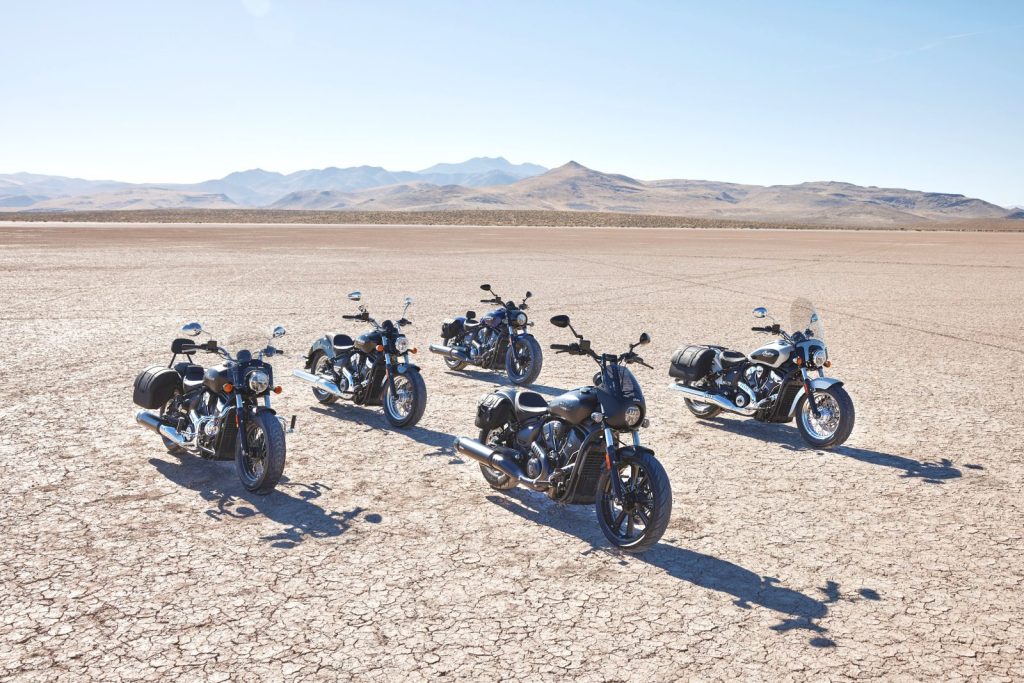The new-for-2025 Indian Scout line-up consists of essentially clean-sheet designs that replace Indian’s best-selling model range, making it the biggest launch since the brand was revived in its current form.
Unlike the previous generation, the new 2025 line-up doesn’t have a basic ‘Scout’ variant. The replacement for that version is now called the Scout Classic. It gains a more traditional style with wire wheels. The Scout Bobber – which has become both the entry point and the best-seller – keeps its name and carries over key styling elements. Then there’s the Sport Scout, which replaces the old Scout Rogue and features a nose cowl and 19-inch front wheel instead of the 16-incher.
Those models are direct replacements for the existing three-bike range, but Indian has also added two high-end models, called the Super Scout, a bagger with a screen and luggage, and the 101 Scout, which gets more performance, high-spec suspension and the Sport Scout’s cowl and larger front wheel.
The Classic, Sport and Bobber are each available in a trio of trim levels, with higher-spec Limited and even more well-equipped Limited+Tech versions available alongside the standard variants.
Both the Super Scout and Scout 101 come only in full-fat Limited+Tech form.

Gone is the old 1133cc V-twin, replaced with a new 1250cc unit that has the same essential architecture but with an increased 12.5:1 compression ratio to help boost power from 70kW to 79kW (106hp) and torque from 97Nm to 108Nm. On the 101 Scout, those numbers are increased to 82kW (110hp) and 109Nm via a revised engine map that will also be offered as a dealer-fitted option for the rest of the range. The engine’s visuals have a less fussy appearance for the cylinders and heads, and exhale through a two-into-one exhaust instead of the old twin-pipe set-up.
The new chassis ditches the cast-aluminium design in favour of steel tubes for the front section, mated to an aluminium casting around the swingarm pivot. The subframe is now shared across all versions, making accessories like seats and luggage universal across the range. The switch from aluminium to more traditional steel has been made possible in part thanks to a new, smaller radiator that can hide between the frame’s downtubes.
The three base versions and the Super Scout all use the same suspension, with a non-adjustable 41mm fork and 120mm of front wheel travel. The preload-adjustable rear shocks are the same across those four bikes, while the Bobber has a lowered rear end that reduces its travel from 76mm to 51mm.
The 101 Scout gets an upside-down, fully-adjustable fork with 150mm of travel with piggyback, adjustable rear shocks.
In terms of brakes, the four lower performance versions get a trio of 298mm discs – two front, one rear – with two-pot calipers at the front and a single pot at the back. The 101 swaps the fronts for 320mm discs and radial-mount Brembo four-piston calipers.
Weights range from 237kg for the Bobber through to 259kg for the Super Scout.
All versions of the Scout get ABS and LED lights, but the Limited pack adds traction control, cruise control and three riding modes. The Limited+Tech trim includes a circular touchscreen display with GPS and turn-by-turn nav, keyless ignition and phone connectivity.
We’re riding the new Scout on the world launch in the USA this week, so look out for our verdict in an upcoming issue.
WORDS: BEN PURVIS
Did you know?
As the entry point to the Indian range, in its various forms the Scout has accounted for more than 100,000 sales since being launched in 2015. This is more than half of all Indians made during that period. Just as importantly, 93 percent of those sales have been to riders who are newcomers to the Indian brand. The Scout is a vital gateway for the company, so it’s essential that the new version is just right.











